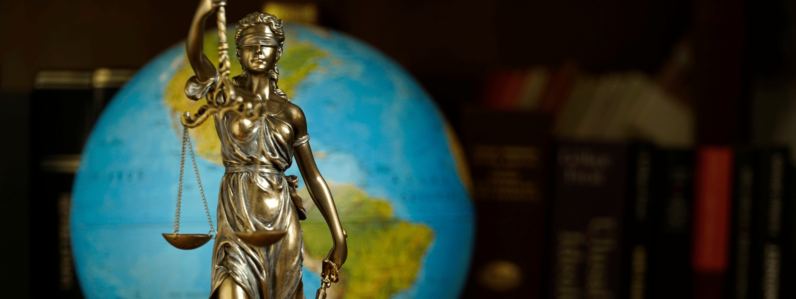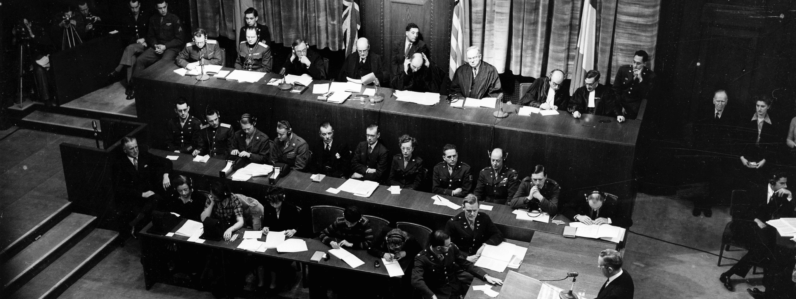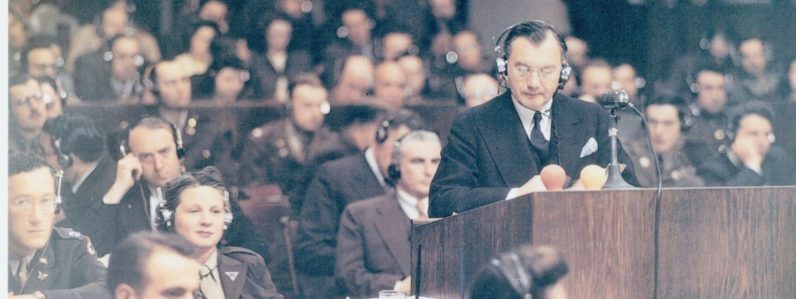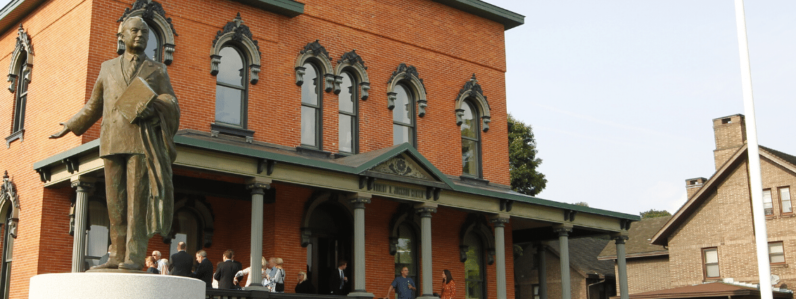Aims & Purpose
Two 40-minute lessons for Grade 11: United States History and Government classes including references to the DVD, Liberty Under Law: The Robert Jackson Story, websites, and student readings.
These lessons address the following content understandings*:
- COLD WAR (1945-1990): In the period following World War II, the United States entered into an extended era of international conflict called the Cold War which influenced foreign and domestic policy for more than 40 years.
11.9a. After World War II, ideological differences led to political tensions between the United States and the Soviet Union. In an attempt to halt the spread of Soviet influence, the United States pursued a policy of containment.
Students will examine the impact of Truman’s decision to fight a limited war in defense of South Korea.
*Taken from: New York State K-12 Social Studies Framework for grades 9-12 (New York State Education Department, 2014), p. 41.
Students will examine:
-The reasons for United States involvement in the war in South Korea,
-The facts involved in the United States Supreme Court case, Youngstown Sheet and Tube Company v. Sawyer,
-The reasons President Harry Truman ordered the federal takeover of the nation’s steel mills,
-The Supreme Court’s decision in the Youngstown case,
-Justice Robert H. Jackson’s concurring opinion in the Youngstown case and its relevance today.
Concepts
Civic values
Government
Judicial Review
Justice
Skills
Gathering, Using, and Interpreting Evidence
Identify, describe, and evaluate evidence about events from diverse sources (including written documents, videos, Internet resources, and other primary and secondary sources).
Chronological Reasoning and Causation
Distinguish between long-term and immediate causes and multiple effects of an event from current events or history
Comparison and Contextualization
Identify, compare and evaluate multiple perspectives of a given historical experience.
*Taken from: New York State K-12 Social Studies Framework for grades 9-12 (New York State Education Department, 2014), pp. 14-17.
Introduction & Background: What was the Korean War and what was its significance in the Youngstown case?
40 minutes
These lessons present the historical background to United States involvement in the Korean War and President Truman’s decision to take over the nation’s steel mills in 1952. These lessons also describe the role of the United States Supreme Court and highlight Justice Robert H. Jackson’s important concurring opinion related to presidential powers and checks and balances.
Have students view that section of the DVD, Liberty Under Law: The Robert Jackson Story, which describes the Youngstown Sheet and Tube Company v. Sawyer case (see beginning at 65:12. As students view this section of the DVD, have them gather information which addresses the following questions:
- Why was the steel industry so important to the United States involvement in the Korean War?
- What arguments did President Truman make in his call for the federal government to take over the nation’s steel industry?
- What arguments did Justice Robert H. Jackson make in his concurring opinion?
- What were the three criteria Justice Jackson outlined in his concurring opinion?
What were the lessons of the steel case decision? Why are these lessons still relevant today?
The United States Supreme Court decision in the Youngstown Sheet and Tube Company v. Sawyer
40 minutes
Provide students with the following facts in the Youngstown steel case:
- The United States was involved in the Korean War.
- The steelworkers wanted higher wages or they were prepared to go on strike.
- A steel strike would shut down the steel mills and hurt the war effort.
- President Truman ordered the Secretary of Commerce, Charles Sawyer, to take over the steel mills and stop the strike.
- The steel companies asked a federal court to overturn President Truman’s decision.
- The case was finally appealed to the United States Supreme Court.
Based on the information in the DVD and these facts of the case, discuss with students the Supreme Court decision in the case. Have students summarize the majority and dissenting opinions. Provide students with a summary of Justice Robert Jackson’s concurring opinion in this case. A summary can be found at http://www.law.cornell.edu/supct/html/historics/USSC_CR_0343_0579_ZC2.html.
Students can also find a summary of the case in Robert H. Jackson by Gail Jarrow (Honesdale, PA: Calkins Creek, 2008), pp 99-101.
Another excellent source for this case is the video, “Key Constitutional Concepts, Part Three, Checks and Balances- Youngstown Sheet and Tube Company v. Sawyer case” at www.AnnenbergClassroom.org. This website also includes a complete lesson plan and student handouts related to this Supreme Court case.
Ask students to discuss Justice Robert Jackson’s rationale for his concurring opinion that opposed President Truman’s takeover of the steel mills. Jackson’s rationale continues to guide executive actions today.
In his opinion, Justice Jackson describes a three-tier framework for evaluating the constitutionality of presidential decisions:
- In the first case, when Congress authorizes presidential action, the president’s authority is at its maximum.
- In the second case, when Congress is silent, the president is limited by Article II of the United States Constitution.
- In the third case, when Congress restricts presidential action, the president’s authority is at its “lowest ebb.”
Two student groups could take opposing sides in a debate about whether the president of the United States should have the authority to take an action like taking control of the nation’s steel mills or coal mines during a national emergency. Ask student groups to present arguments on both sides of the issue based on the Youngstown case. A third student group could serve as an appeals court panel reviewing their arguments. This group of judges could vote to rule on the motion to allow or disallow the president’s actions. These judges could also present their majority and minority opinions on this issue.
Ask student groups to investigate more recent examples of conflicts over the separation of powers and have them explain how Justice Robert H. Jackson’s framework applies. A background article for teachers can be found at: Social Education, www.socialstudies.org/publications. Find: Steven D. Schwinn, “The Separation of Powers and 15 Years of Anti-Terrorism Policies Since 9/11,” Social Education, September 2016, pp. 214-218, 223.
Student groups can present their examples to the class using the case study method by presenting the facts of the case, the arguments for each side, and the court’s rulings including majority/ minority opinions. Student groups should also relate their findings to Justice Jackson’s framework from the Youngstown decision.
Two 40-minute lessons for Grade 11: United States History and Government classes including references to the DVD, Liberty Under Law: The Robert Jackson Story, websites, and student readings.
These lessons address the following content understandings*:
- COLD WAR (1945-1990): In the period following World War II, the United States entered into an extended era of international conflict called the Cold War which influenced foreign and domestic policy for more than 40 years.
11.9a. After World War II, ideological differences led to political tensions between the United States and the Soviet Union. In an attempt to halt the spread of Soviet influence, the United States pursued a policy of containment.
Students will examine the impact of Truman’s decision to fight a limited war in defense of South Korea.
*Taken from: New York State K-12 Social Studies Framework for grades 9-12 (New York State Education Department, 2014), p. 41.
Students will examine:
-The reasons for United States involvement in the war in South Korea,
-The facts involved in the United States Supreme Court case, Youngstown Sheet and Tube Company v. Sawyer,
-The reasons President Harry Truman ordered the federal takeover of the nation’s steel mills,
-The Supreme Court’s decision in the Youngstown case,
-Justice Robert H. Jackson’s concurring opinion in the Youngstown case and its relevance today.
Civic values
Government
Judicial Review
Justice
Skills
Gathering, Using, and Interpreting Evidence
Identify, describe, and evaluate evidence about events from diverse sources (including written documents, videos, Internet resources, and other primary and secondary sources).
Chronological Reasoning and Causation
Distinguish between long-term and immediate causes and multiple effects of an event from current events or history
Comparison and Contextualization
Identify, compare and evaluate multiple perspectives of a given historical experience.
*Taken from: New York State K-12 Social Studies Framework for grades 9-12 (New York State Education Department, 2014), pp. 14-17.
Introduction & Background: What was the Korean War and what was its significance in the Youngstown case?
40 minutes
These lessons present the historical background to United States involvement in the Korean War and President Truman’s decision to take over the nation’s steel mills in 1952. These lessons also describe the role of the United States Supreme Court and highlight Justice Robert H. Jackson’s important concurring opinion related to presidential powers and checks and balances.
Have students view that section of the DVD, Liberty Under Law: The Robert Jackson Story, which describes the Youngstown Sheet and Tube Company v. Sawyer case (see beginning at 65:12. As students view this section of the DVD, have them gather information which addresses the following questions:
- Why was the steel industry so important to the United States involvement in the Korean War?
- What arguments did President Truman make in his call for the federal government to take over the nation’s steel industry?
- What arguments did Justice Robert H. Jackson make in his concurring opinion?
- What were the three criteria Justice Jackson outlined in his concurring opinion?
What were the lessons of the steel case decision? Why are these lessons still relevant today?
The United States Supreme Court decision in the Youngstown Sheet and Tube Company v. Sawyer
40 minutes
Provide students with the following facts in the Youngstown steel case:
- The United States was involved in the Korean War.
- The steelworkers wanted higher wages or they were prepared to go on strike.
- A steel strike would shut down the steel mills and hurt the war effort.
- President Truman ordered the Secretary of Commerce, Charles Sawyer, to take over the steel mills and stop the strike.
- The steel companies asked a federal court to overturn President Truman’s decision.
- The case was finally appealed to the United States Supreme Court.
Based on the information in the DVD and these facts of the case, discuss with students the Supreme Court decision in the case. Have students summarize the majority and dissenting opinions. Provide students with a summary of Justice Robert Jackson’s concurring opinion in this case. A summary can be found at http://www.law.cornell.edu/supct/html/historics/USSC_CR_0343_0579_ZC2.html.
Students can also find a summary of the case in Robert H. Jackson by Gail Jarrow (Honesdale, PA: Calkins Creek, 2008), pp 99-101.
Another excellent source for this case is the video, “Key Constitutional Concepts, Part Three, Checks and Balances- Youngstown Sheet and Tube Company v. Sawyer case” at www.AnnenbergClassroom.org. This website also includes a complete lesson plan and student handouts related to this Supreme Court case.
Ask students to discuss Justice Robert Jackson’s rationale for his concurring opinion that opposed President Truman’s takeover of the steel mills. Jackson’s rationale continues to guide executive actions today.
In his opinion, Justice Jackson describes a three-tier framework for evaluating the constitutionality of presidential decisions:
- In the first case, when Congress authorizes presidential action, the president’s authority is at its maximum.
- In the second case, when Congress is silent, the president is limited by Article II of the United States Constitution.
- In the third case, when Congress restricts presidential action, the president’s authority is at its “lowest ebb.”
Two student groups could take opposing sides in a debate about whether the president of the United States should have the authority to take an action like taking control of the nation’s steel mills or coal mines during a national emergency. Ask student groups to present arguments on both sides of the issue based on the Youngstown case. A third student group could serve as an appeals court panel reviewing their arguments. This group of judges could vote to rule on the motion to allow or disallow the president’s actions. These judges could also present their majority and minority opinions on this issue.
Ask student groups to investigate more recent examples of conflicts over the separation of powers and have them explain how Justice Robert H. Jackson’s framework applies. A background article for teachers can be found at: Social Education, www.socialstudies.org/publications. Find: Steven D. Schwinn, “The Separation of Powers and 15 Years of Anti-Terrorism Policies Since 9/11,” Social Education, September 2016, pp. 214-218, 223.
Student groups can present their examples to the class using the case study method by presenting the facts of the case, the arguments for each side, and the court’s rulings including majority/ minority opinions. Student groups should also relate their findings to Justice Jackson’s framework from the Youngstown decision.
Gathering, Using, and Interpreting Evidence
Identify, describe, and evaluate evidence about events from diverse sources (including written documents, videos, Internet resources, and other primary and secondary sources).
Chronological Reasoning and Causation
Distinguish between long-term and immediate causes and multiple effects of an event from current events or history
Comparison and Contextualization
Identify, compare and evaluate multiple perspectives of a given historical experience.
*Taken from: New York State K-12 Social Studies Framework for grades 9-12 (New York State Education Department, 2014), pp. 14-17.
Introduction & Background: What was the Korean War and what was its significance in the Youngstown case?
40 minutes
These lessons present the historical background to United States involvement in the Korean War and President Truman’s decision to take over the nation’s steel mills in 1952. These lessons also describe the role of the United States Supreme Court and highlight Justice Robert H. Jackson’s important concurring opinion related to presidential powers and checks and balances.
Have students view that section of the DVD, Liberty Under Law: The Robert Jackson Story, which describes the Youngstown Sheet and Tube Company v. Sawyer case (see beginning at 65:12. As students view this section of the DVD, have them gather information which addresses the following questions:
- Why was the steel industry so important to the United States involvement in the Korean War?
- What arguments did President Truman make in his call for the federal government to take over the nation’s steel industry?
- What arguments did Justice Robert H. Jackson make in his concurring opinion?
- What were the three criteria Justice Jackson outlined in his concurring opinion?
What were the lessons of the steel case decision? Why are these lessons still relevant today?
The United States Supreme Court decision in the Youngstown Sheet and Tube Company v. Sawyer
40 minutes
Provide students with the following facts in the Youngstown steel case:
- The United States was involved in the Korean War.
- The steelworkers wanted higher wages or they were prepared to go on strike.
- A steel strike would shut down the steel mills and hurt the war effort.
- President Truman ordered the Secretary of Commerce, Charles Sawyer, to take over the steel mills and stop the strike.
- The steel companies asked a federal court to overturn President Truman’s decision.
- The case was finally appealed to the United States Supreme Court.
Based on the information in the DVD and these facts of the case, discuss with students the Supreme Court decision in the case. Have students summarize the majority and dissenting opinions. Provide students with a summary of Justice Robert Jackson’s concurring opinion in this case. A summary can be found at http://www.law.cornell.edu/supct/html/historics/USSC_CR_0343_0579_ZC2.html.
Students can also find a summary of the case in Robert H. Jackson by Gail Jarrow (Honesdale, PA: Calkins Creek, 2008), pp 99-101.
Another excellent source for this case is the video, “Key Constitutional Concepts, Part Three, Checks and Balances- Youngstown Sheet and Tube Company v. Sawyer case” at www.AnnenbergClassroom.org. This website also includes a complete lesson plan and student handouts related to this Supreme Court case.
Ask students to discuss Justice Robert Jackson’s rationale for his concurring opinion that opposed President Truman’s takeover of the steel mills. Jackson’s rationale continues to guide executive actions today.
In his opinion, Justice Jackson describes a three-tier framework for evaluating the constitutionality of presidential decisions:
- In the first case, when Congress authorizes presidential action, the president’s authority is at its maximum.
- In the second case, when Congress is silent, the president is limited by Article II of the United States Constitution.
- In the third case, when Congress restricts presidential action, the president’s authority is at its “lowest ebb.”
Two student groups could take opposing sides in a debate about whether the president of the United States should have the authority to take an action like taking control of the nation’s steel mills or coal mines during a national emergency. Ask student groups to present arguments on both sides of the issue based on the Youngstown case. A third student group could serve as an appeals court panel reviewing their arguments. This group of judges could vote to rule on the motion to allow or disallow the president’s actions. These judges could also present their majority and minority opinions on this issue.
Ask student groups to investigate more recent examples of conflicts over the separation of powers and have them explain how Justice Robert H. Jackson’s framework applies. A background article for teachers can be found at: Social Education, www.socialstudies.org/publications. Find: Steven D. Schwinn, “The Separation of Powers and 15 Years of Anti-Terrorism Policies Since 9/11,” Social Education, September 2016, pp. 214-218, 223.
Student groups can present their examples to the class using the case study method by presenting the facts of the case, the arguments for each side, and the court’s rulings including majority/ minority opinions. Student groups should also relate their findings to Justice Jackson’s framework from the Youngstown decision.






